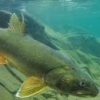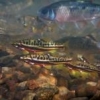
Some Food for Thought
#1

Posted 29 December 2014 - 05:36 PM
I assume most of us on here are familiar enough with Rhinichthys. This genus of Cyprinids have Inferior mouths due to their primary habitat being riffles and them being bottom grazers. Many are also familiar with the fact that they adapt quite well to living and feeding in tanks with little flow such as only a sponge filter and that they will invert their bodies at an angle, sometimes even turning upside down to feed after being in such a captive environment for as little time as a few days. Well think about this. If we were to captive breed this fish hundreds or even thousands of generations inside tanks with the only flow being a sponge filter (assume that the fry would be bred with other batches to prevent genetic problems) would they eventually adapt and change the structure of their mouth to a terminal one in order to feed more easily in such an environment? Just something to think about.
#2

Posted 29 December 2014 - 07:51 PM
#3

Posted 29 December 2014 - 07:54 PM
Gerald Pottern
-----------------------
Hangin' on the Neuse
"Taxonomy is the diaper used to organize the mess of evolution into discrete packages" - M.Sandel
#4

Posted 29 December 2014 - 11:00 PM
Derek Wheaton
On a mountain overlooking the North Fork Roanoke River on one side, the New River Valley on the other, and a few minutes away from the James River watershed...the good life...
Enchanting Ectotherms
My Personal Facebook (mostly fish related, if you'd like to add me)
Reply to this topic
0 user(s) are reading this topic
0 members, 0 guests, 0 anonymous users










